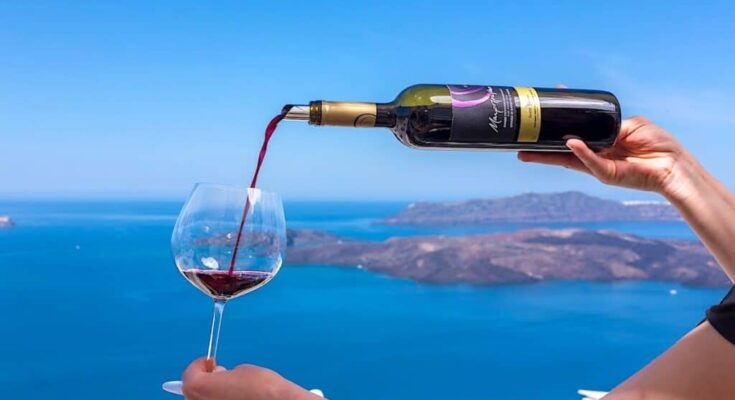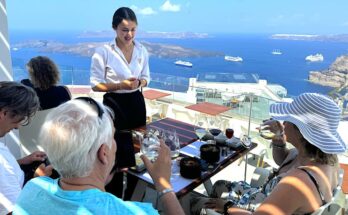
The world famous Santorini wines, produced from volcanic vineyards for millennia, are facing unprecedented challenges as their crops are being affected by drought, local winegrowers warn.
At the same time, the gradual yet steady shrinking of the local viticulture terroir, a result of the unregulated touristic development of land on the island, is another contributing factor in the crisis.
This harvest season, the world-famous Cycladean island reached a historic low in grape production, looking at a total of 650 to 700 tons produced as opposed to an average 3,000 in the past. This has made 2024 a “catastrophic” year for Santorini wines.
Local geology and sustainable growth make Santorini wines unique
The exquisite quality of Santorini wines is certified by the EU’s Protected Designation of Origin stamp, which defines and safeguards its special characteristics, exclusive to the island’s particular geographical environment and inherent qualities.
Wine production on Santorini dates back to the 3rd millennium BC, and, according to archaeological finds, its vineyards have produced wine uninterrupted for 4,000 years with only a 300-year break following the infamous volcanic eruption that covered the island in ash.
Today, these ancient, nutrient-rich vineyards are recognized as among the world’s oldest and best.

Vines grown on Santorini are ungrafted with minimal cultivation or human interference, presenting a great wealth of almost thirty ancient Greek indigenous varieties that survive to this day.
“Santorini vineyards truly are cultural monuments and monuments of nature, as the most historic, the most ancient vineyards in Greece,” says Markos Kafouros, winegrower, Chairman of Santo Wines Winery, and Cyclades MP with the ruling party New Democracy.
“Santorini wine is the ambassador of Greek winemaking abroad,” he adds. “The volcanic substrate provides the local wine with unique characteristics: its high acidity, its distinct minerality, its very strong body.”
The organoleptic properties of other renowned local agricultural products—such as the Santorini plum tomato, fava beans, round zucchini, and white and green eggplant—are also owed to the volcanic provenance of the territory.
Dual challenge for Santorini wines
From his experience, Kafouros considers climate change and the loss of farmland as the two plagues endangering the survival of Santorini wines.
On the one hand, the lack of designated use of land limitations allows the tourist sector to directly compete with the farming sector over very limited available space on this tiny Cycladic island of 76 square meters, while on the other hand, climate change “arrived much faster than expected and found us all unprepared.”
The MP believes that desertification is an imminent risk not only to winegrowing but to the entire primary sector on the Cyclades. He has noticed that vineyard loss has stabilized in the past 25 years, however. Still, the drop seems substantial in retrospective. From the 30,000 acres of vineyards in 1961, there were only 20,000 left in 1971. Today, this has dropped to about 8,000 to 10,000.

The extremely limited harvest of 2024 has resulted in the steep increase in the price of the grapes, climbing to at least seven to eight euros per kilogram, whereas PDO grapes in other parts of Greece sell for eighty euro cents on average.
“As wineries, we are bleeding, but we do pay the price to give incentive to the winegrowers, especially the younger generations, to stay in the vineyard and not quit, even if this is just their secondary income,” Kafouros points out.
The Greek agricultural insurance institute (ELGA) is yet to acknowledge the crisis and provide for compensation for loss of income, except maybe for a very small area that was damaged by hail, not the drought.
“If we do not think about the problem now to understand the issues and their projection in time, we will surely be led to absolute disaster,” Kafouros concludes.
Future of Santorini viticulture becomes uncertain
For Mattheos Dimopoulos, the general manager of the Union of Santo Wines Cooperatives of Thira, Santorini, the very existence and wellbeing of the vineyards constitute an upgrade of the tourist product in itself. They offer an idyllic natural environment that adds to the visitor experience.
He insists that the island needs to implement designated use of land for the vineyards to prevent anyone from building within the borders of those areas.
A 2012 Presidential decree that prevented vineyards outside the city plan to change their use into building development has somehow limited the shrinking of the terroir, although it has not eradicated the problem, as it does not include plots located in vineyard areas not cultivated before. The use of those can still be altered.
“If we lose the vineyards and the primary sector, our tourist product will lose its attractiveness. The caldera experience alone is not enough [to sustain tourism],” he opines.
The historic low grape supply of 2024 causes Dimopoulos great concern: “As you understand, the low supply also clearly affects the future of viticulture on the island, because of the disappointment it causes to the producer. No matter what high price they may get, when the crop is small, the income will stay low. This is blocking us, and our hope is that new people will get involved. But if they don’t make anything, how are they going to?”

Catastrophic year for local vine harvest
Producers themselves point out multiple obstacles that discourage them from carrying on with viticulture.
“The grandpas who used to farm the vines slowly quit, and the youth turns to the tourism sector for income. Nobody goes into the vineyards anymore. Climate change-related problems have also recently started. The vines are struggling, the costs for fertilizers are raised, and working hands are rare,” young Santorini winegrower Tzennis Dartzentas says of the situation.
“Years like this can be catastrophic,” he comments. Land rental prices have skyrocketed, while most land owners choose to sell to building developers rather than rent or sell to producers, so any prospect disappears for the latter to expand their crops.
For the past two to three years, the local vineyards, which have always been naturally anhydrous, dry crops with no need for irrigation, are challenged by the drought caused by high temperatures and lack of rainfall.
When in conditions of extreme drought, vines of the indigenous Assyrtiko variety, Santorini’s most prominent kind, waste their fruit so the tree can survive, which is not the case with varieties in other Greek vineyards.
“This means that, in a year when the vine struggles, there is no produce,” Dartzentas stresses. “A good year means 300 kilograms per acre, as opposed to at least one ton on other areas of Greece. For us, there are years where we might harvest just 50 or 100 kilograms. That’s why [the grape] has this value and such rarity; it’s very little, but good.”
According to latest estimates, 2024’s harvest season on Santorini ended with an average seventy kilograms of grape per acre.
Santorini strategy against drought
At present, Santorini Mayor Nikos Zorzos is looking for solutions to the drought that has been impacting the grape produce since the vines that never needed irrigation before will need to be irrigated until at least March or April of each year under the new weather conditions.

“In the last two to three years, the lack of rain has created a very big problem. This year has been a very bad one not only in terms of production, but also because it poses the question of whether the vineyard will continue to exist in the future,” Zorzos says.
A study on the potential utilization of the waters from biological treatment plants in irrigation is expected to be completed by the end of September.
In addition, an irrigation network will be needed, which could be financed by a suitable development fund.
“That network should run the entire island, as our vineyards extend from North to South, and the state must see this with a positive eye,” Zorzos hopes. He also suggests the establishment of generous incentives by the government for local winegrowers, not only on Santorini but across the country, depending on each location’s specific challenges and peculiarities.
“Any economy needs to be able to count on its own production too, besides the services economy. We need to sustain the vineyard as well as the rest of our agricultural products. And by protecting our natural environment, we also protect our tourism,” the mayor observes.



